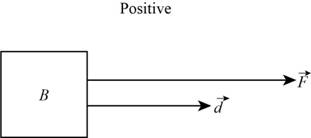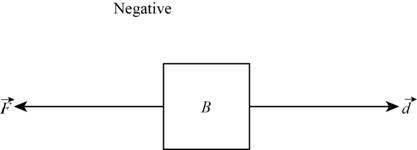
Concept explainers
Recall the definition of work done on an object by an agent that exerts a force on that object. (You may wish to consult your textbook.)
In the spaces provided, sketch arrows representing (1) a force exerted on an object and (2) the displacement of that object for cases in which the work done by the agent is:
In each case, does your sketch represent the only possible relative directions of the force and displacement vectors? If so, explain. If not, sketch at least one other possible set of vectors.
The direction of the force exerted on an object and the direction of displacement of an object for different cases.
Explanation of Solution
Introduction:
Work is the measure of energy transferred when a force is applied to move an object through a displacement. Work done by a force acting on an object is equal to the product of the magnitude of the displacement and the component of force parallel to that displacement.
When work done on an object is positive, then the direction of the force exerted on an object and the direction of displacement of an object is the same.
The direction of force and displacement of an object when the work done is positive is shown in figure 1.

Figure 1
When work done on an object is negative, then the direction of the force exerted on an object and the direction of displacement of an object is the opposite.
The direction of force and displacement of an object when work done is negative is shown in figure 2

Figure 2
When work done is zero, then, in this case, either displacement is zero or there is no change in the kinetic energy.
The direction of force and displacement of an object when the work done is negative is shown in figure 3.

Figure 3
Conclusion:
Therefore, the direction of force and displacement for positive, negative and zero work done is shown in figure 1, 2 and 3 respectively.
Want to see more full solutions like this?
Chapter 13 Solutions
Tutorials in Introductory Physics
Additional Science Textbook Solutions
University Physics Volume 1
College Physics: A Strategic Approach (4th Edition)
College Physics (10th Edition)
Physics for Scientists and Engineers: A Strategic Approach with Modern Physics (4th Edition)
Physics for Scientists and Engineers: A Strategic Approach, Vol. 1 (Chs 1-21) (4th Edition)
Physics (5th Edition)
- d. The rod moves 3.0 m/s to the right because an external agent is exerting a constantforce on it to the right. What is the magnitude of this force? e. Use your answer to part (d) to find the rate at which the external agent does workon the rod.f. Discuss the significance of your results for parts (c) and (e)arrow_forwardCan you please provide a complete solution set to this problem? Please do not skip any steps and please double check your work. How do I find out what the final kinetic energy is? How do I find out how much the initial kinetic energy is? How do I find how much kinetic energy is lost? THANK YOU!arrow_forwardThe work done by a variable force is given by W = ∫ F dx. Calculating this integral is equivalent to calculating the area under the F vs. x curve! Estimate the work (in Joules) that was done to stretch the rubber band from x = 0 (unstretched) to x = 1/2 xmax (half of the maximum stretch). Approximate the area under the curve using 5 vertical columns, as shown below. Draw the columns used onto the F vs. x graph for the rubber band, and show your calculation in the space below.arrow_forward
- What general principle can you conclude about work, potential energy, and kinetic energy from these experiments? Be sure to discuss the transformation of potential energy (U) to kinetic energy (K) in your answer.arrow_forwardThe variable force shown to the right movesan object from position x=0 to x=16 m.a) How much work is done by the force?b) Assume the object started from rest and weighs 15 kg.What is its final velocity?arrow_forwardThe force on a body is not constant, but it varies as a function of the displacement of the body along the x axis, according to the graph below. (a) How much work is done by the force as the body moves from x=0 to x=3m? (b) What is the work done by the force on the body during to motion from x=3m to x=10m? (c) In which phase(s) during the motion is the force like a force exerted by a spring? please show your work, including diagrams, algebraic equations, and enough written explanations that somebody who is not familiar with the problem could understand what you are doing.arrow_forward
- The work done by a conservative force is indicated in the figure for a variety of different paths connecting the points A and B. What is the work done by this force on path 1? What is the work done by this force on path 2?arrow_forwardplease help with all parts, show work and please at the end list the answers to all parts.arrow_forwardSolve and show the proper solution. A factory worker pushes a 40-kg crate a distance of 4.0 m along a level floor at constant velocity by pushing horizontally on it. The coefficient of kinetic friction between the crate and the floor is 0.22. (a) What magnitude of force must the worker apply? (b) How much work is done on the crate by this force? (c) How much work is done on the crate by friction?arrow_forward
- I am still not sure how you got to the final result. I am still studying the work-energy theorem and on case 2 I don't understand how you simplified from the 1st formula line to the 2nd line. Can you please explain?arrow_forwardCan you show me how on part b your W1,...W4? I'm confused how you got 0 for W1 and all the other values for total Work.arrow_forwardCan you help me answer the questions on this graph? And if possible, can you show the workarrow_forward
 Glencoe Physics: Principles and Problems, Student...PhysicsISBN:9780078807213Author:Paul W. ZitzewitzPublisher:Glencoe/McGraw-Hill
Glencoe Physics: Principles and Problems, Student...PhysicsISBN:9780078807213Author:Paul W. ZitzewitzPublisher:Glencoe/McGraw-Hill
